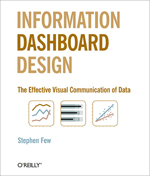According to Few, while today’s business intelligence (BI) software vendors have developed technologies that can gather data from disparate sources, transform data into more usable forms, store huge repositories of data in high-performance databases, and present data in the form of reports, “we have made little progress in using that information effectively.” This book provides a sound foundation in the principles of visual perception and communication that you must understand to design effective dashboards and offers guidelines for creating dashboards that provide engaging interactions “for exploring and analyzing structured, domain-specific information… to discern business trends or patterns.”
Organization
This well-structured book consists of eight chapters that follow a logical progression and build upon one another—plus a table of contents, introduction, appendix, and index—as follows:
- Table of Contents
- Introduction
- Chapter 1—Clarifying the Vision
- Chapter 2—Variations in Dashboard Uses and Data
- Chapter 3—Thirteen Common Mistakes in Dashboard Design
- Chapter 4—Tapping Into the Power of Visual Perception
- Chapter 5—Eloquence Through Simplicity
- Chapter 6—Effective Dashboard Display Media
- Chapter 7—Designing Dashboards for Usability
- Chapter 8—Putting It All Together
- Appendix
- Index
Each chapter comprises a title page with an introductory paragraph of text, a sort of chapter table of contents, and effectively chunked sections—within which the presentation of information is appropriate to the content, often including bulleted or other types of lists, simple tables, and side notes that provide reference information or explanatory text. Unfortunately, the section headings don’t precisely match the topics in the chapter tables of contents.
The very brief Introduction to this book eloquently states Few’s viewpoint on the current state and potential of information dashboards.
In Chapter 1, Few deplores the deficiencies that are characteristic of most information dashboards today and thereby establishes the need for the information his book provides. According to Few, because of their poor visual design, most dashboards fail to live up to the potential this medium of communication offers. So far, developers have emphasized flashy, colorful displays rather than the clear communication of information that meets people’s needs. After giving a brief history of dashboards in software, this chapter presents a collection of thirteen representative dashboards, then defines precisely what a dashboard is, identifies their common characteristics, and describes the value of dashboards.
Chapter 2 outlines the various ways in which one can categorize types of dashboards, including by role—strategic, analytical, or operational—quantitative or non-quantitative data, data domain or span, update frequency, static or interactive display, graphic and/or text display mechanisms, and whether a dashboard functions as a portal. This chapter also describes typical dashboard data, including both quantitative measures of current activity—displayed in various timeframes, compared with related measures, or enriched with status indicators—and non-quantitative data.
Chapter 3 gets specific about the problems that are endemic in dashboard design. It covers thirteen common design mistakes that undermine the usefulness of dashboards. These include exceeding the boundaries of a single screen, supplying inadequate context for data, displaying excessive detail or precision, choosing a deficient measure, using inappropriate or poorly designed display media, introducing meaningless variety in the display media, encoding quantitative data inaccurately, and visual design mistakes—laying out data poorly, failing to effectively highlight important data, adding useless visual clutter, misusing color, and designing an unaesthetic visual display.
In Chapter 4, Few begins building the foundations of good dashboard design. He delves into the science of visual perception, describing the role of iconic memory, or the visual sensory register, and the limits of short-term memory in visual perception. He also discusses various means of visually encoding data for rapid perception and the Gestalt principles of visual perception and how to apply them to dashboard design.
In Chapter 5, Few establishes simplicity as the guiding principle in dashboard design and discusses condensing information through summarization and exception. Few summarizes his two key goals in dashboard design, as follows:
- Reducing non-data pixels by eliminating all unnecessary pixels and de-emphasizing and regularizing those that remain.
- Enhancing the data pixels by eliminating all that are unnecessary and highlighting the most important of the remaining data pixels.
By far the longest chapter in the book, Chapter 6 presents a library of effective dashboard display media. Few explains how to select the most appropriate display medium—either text, graphics, or some combination of the two. Once a designer has made this fundamental choice for each piece of information on a dashboard, the next step is to choose their optimal display media.
Chapter 7 discusses designing dashboards for usability, describing how to organize dashboards according to their meaning and use, maintain consistency, create aesthetically pleasing dashboards, and design a dashboard to function as a portal that lets users access additional, complementary information.
Finally, in Chapter 8, Few evaluates the pros and cons of eight different sales dashboards. Building on the principles and guidelines he’s provided in the foregoing chapters, Few presents several of his own exemplary dashboard designs:
- sales dashboard—which a sales manager could use to monitor sales performance and strategic opportunities
- CIO dashboard—which a Chief Information Officer could use to monitor the performance of a company’s information systems
- telesales dashboard—which a supervisor of a team of sales representatives could use to monitor the team’s performance
- marketing analysis dashboard—which a marketing analyst could use to monitor the marketing performance of a company’s Web site
A brief Appendix of recommended reading concludes the book.
Content
Few defines an information dashboard as a “single-screen display of the most important information people need to do a job, presented in a way that allows them to monitor what’s going on in an instant.” He views an effective dashboard as a powerful medium of communication. Here is how he describes the challenging design problem that information dashboards present:
“To serve their purpose and fulfill their potential, dashboards must display a dense array of information in a small amount of space in a manner that communicates clearly and immediately. This requires design that taps into and leverages the power of visual perception to sense and process large chunks of information rapidly. This can be achieved only when the visual design of dashboards is central to the development process and is informed by a solid understanding of visual perception—what works, what doesn’t, and why.”
About Dashboards
Few defines the salient characteristics of a dashboard, as follows:
- “Dashboards are visual displays.”
- “Dashboards display the [most important] information needed to achieve specific objectives.”
- “A dashboard fits on a single computer screen.”
- “Dashboards are used to monitor information at a glance.”
- “Dashboards have small, concise, clear, and intuitive display mechanisms.”
- “Dashboards are… tailored specifically to the requirements of a given person, group, or function….”
Few explains, “Graphical information, handled expertly, can often communicate with greater efficiency and richer meaning than text alone.” Almost all of the information in dashboards “is abbreviated in the form of summaries or exceptions. … A dashboard must be able to quickly point out that something deserves your attention and might require action. It needn’t provide all the details necessary to take action, but… it ought to make it as easy… as possible to get to that information.”
Because of the limited capacity of short-term memory, Few insists that “a dashboard should confine its display to a single screen, with no need for scrolling or switching between multiple screens. … One of the great benefits of a dashboard as a medium of communication is the simultaneity of vision that it offers: the ability to see everything that you need at once. ”
The role a dashboard plays—whether strategic, analytical, or operational—has the greatest impact on its visual design. Few says, “The design characteristics of the dashboard can be tailored to effectively support the needs of each of these roles. … The primary use of dashboards today is for strategic purposes. … They provide the quick overview that decision makers need to monitor the health and opportunities of the business. Dashboards of this type focus on high-level measures of performance, including forecasts…. Extremely simple display mechanisms work best for this type of dashboard.” Most dashboards “primarily display quantitative measures of what’s currently going on. … These measures are often expressed in summary form…. ”
While most of the information dashboards typically present is quantitative, “not all information that is useful on dashboards is… quantitative—the critical information needed to do a job cannot always be expressed numerically,” according to Few. Such non-quantitative data commonly includes simple lists—such as the top ten customers, issues, or tasks—schedules, project management information, process flows, or organization charts.


